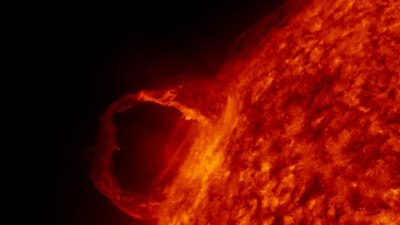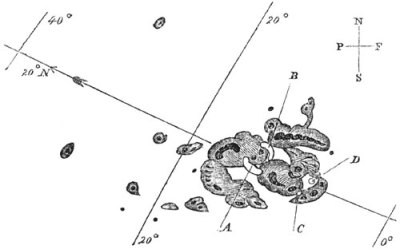There are a bunch of ways to estimate the age of a radio amateur, by the letters in their callsign, by their preferred choice of homebrewing technology, or sometimes by their operating style. One that perhaps doesn’t immediately come to mind is to count how many solar cycles they remember, and since the current cycle 25 is my fourth I guess I’ve seen a few. Cycle 25 is so far shaping up to be quite an active one especially of late, which popular media are describing as bombarding us with flares from a “sunspot archipelago” and the more measured tones of spaceweather.com giving us warning of X-class flares heading in our direction, today!

As the technology for solar observation has increased in sophistication and the Internet has allowed anyone to follow the events above us as they unfold, the awareness of solar phenomena has shifted away from the relatively small numbers of astronomers and radio amateurs who would once have been eagerly awaiting a solar cycle to a wider audience. Ever since a particularly severe event in March 1989 during cycle 22 caused disruptions including the blackout of a significant part of Canada it’s been a periodic topic of mild doom in slow news moments. But what lies behind the reports of solar activity? Perhaps it’s time to take a look.
The solar cycle refers to the 11-year period of solar activity from a maximum of observed sunspots through a minimum to a new maximum. The sunspots are the visible evidence of the solar magnetic field changing its polarity, and appear as darker areas where there is a greater strength of magnetic flux in the sun’s photosphere. We refer to solar cycles by number with solar cycle 1 occurring in 1755 because that year represents the earliest cycle which can be found in modern astronomical observation data, but previous cycles have been deduced over millennia through dendrochronology, sediment analysis, isotope observations, and other methods.

The sunspots are interesting to observe, but of course it’s the other effects of a solar cycle which make them of concern here on Earth. What happens on the sun has an effect here in terms of variations in solar radiation and magnetic field, but the phenomenon which captures the most attention comes directly from the sunspots themselves. In high-school physics terms, where there is a concentration of magnetic field there are more of those magnetic field lines your teacher probably drew for you on the board, and energetic charged material is drawn out from the surface of the sun along those lines. When that concentration of magnetic field breaks down there is a so-called coronal mass ejection, in which those particles are expelled into space. If we on our orbiting planet happen to lie in the path of one of these ejections our atmosphere is bombarded with these charged particles, and life becomes interesting for a while.
Our planet has its own magnetic field, and as the particles hit the atmosphere an electrical current starts flowing in the direction of that planetary field. This in turn becomes concentrated near the polar regions where the magnetic flux is at its most dense, and leads to a concentration of ionised particles in the atmosphere. We can see these as the aurora borealis, and in that lies the reason radio amateurs get excited about sunspot maxima. An aurora makes for a surprisingly effective radio reflector, allowing contacts to be made over much longer distances than normal.

As we’ve discussed, the solar cycle has been in operation since time immemorial, and every eleven years over the relative blink of an eye spanning our industrial recent history it’s been studied by scientists. It’s a phenemenon that shows significant variation, with the scientific record showing evidence of cycles with almost no activity as well as extremely violent moments. As much as any solar cycle can be considered normal, in a normal cycle it causes pretty light shows for people in polar regions and gets radio amateurs and solar astronomers excited, and that’s about it.
Where it crosses the boundary into public consciousness is when a cycle is particularly strong, and so far in cycle 25 it seems this applies to the moment. If we cross the path of a particularly strong coronal mass ejection those currents in our outer atmosphere in turn become particularly strong, and we begin to see immediate effects on the ground. The first cycle I saw as a spotty teen was cycle 22, and it had a higher-than average activity that certainly had multiple effects on the ground. In March 1989 durning cycle 22 for example there was a particularly strong geomagnetic storm, which famously caused a power blackout across large parts of eastern Canada. Of these stronger cycles perhaps the most famous was solar cycle 10, when in September 1859 the strongest recorded storm was observed. Dubbed the Carrington event after the astronomer who characterised it, this storm caused auroras to be seen at tropical latitudes, and it gave telegraph operators shocks and allowed the operation of long-distance telegraph circuits without external power.

In the 1850s the telegraph was perhaps somewhere near the pinnacle of electronic technology, while today our lives depend on many thousands of electronic circuits that have become the stock-in-trade of Hackaday readers. We have satellites overhead, computers in our pockets, computers controlling our utilities, our cars, and much more. It’s the threat of another storm in the magnitude of the Carrington event or higher which should occupy our minds, because it’s likely that much of that circuitry would be in some way damaged by it with consequent effect on services.
Even then though, it’s worth injecting a measure of common sense, because a study of the list of past intense solar storms will show that these are not an uncommon phenomenon. You and I have all lived through a few, and while they aren’t all on the scale of the Carrington event or even the 1989 storm, in practice most of them passed us by unnoticed. It’s likely that if a solar cycle appears to be approaching Carrington levels of activity we’ll have some warning from the astronomers, a lot of interesting scientific research will be done, and with luck the impact of some of our devices going offline will be minimised.
So perhaps we should treat the headlines with amusement rather than fear. If you see the astronomers and the radio amateurs digging shelters get worried, but if the hams are in the shack chasing the DX, watch out for the pretty light show instead.
Header image: NASA, public domain.
- SEO Powered Content & PR Distribution. Get Amplified Today.
- PlatoData.Network Vertical Generative Ai. Empower Yourself. Access Here.
- PlatoAiStream. Web3 Intelligence. Knowledge Amplified. Access Here.
- PlatoESG. Carbon, CleanTech, Energy, Environment, Solar, Waste Management. Access Here.
- PlatoHealth. Biotech and Clinical Trials Intelligence. Access Here.
- Source: https://hackaday.com/2023/12/01/the-sunspots-are-coming-again/



